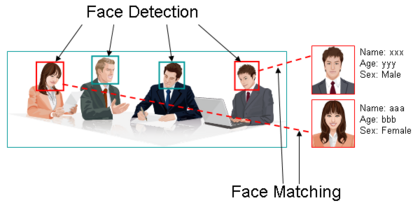Warning:
This wiki has been archived and is now read-only.
Use Cases & Requirements/Security Services using Video Analysis
Contents
Abstract
This document proposes following 3 use cases of media fragments in security services using video analysis:
- Face Recognition
- Trajectory Analysis
- Clothes Recognition
This document is a contribution for “4. Use Cases” in “Use cases and requirements for Media Fragments”. http://www.w3.org/2008/WebVideo/Fragments/WD-media-fragments-reqs/
Use case 1: Face Recognition
Abstract
Face recognition system is used in various security systems, such as building entrance security system, suspicious individual detection system, and so on. Building entrance security system authenticates the person standing in front of the video camera installed at the entrance of the building. Suspicious individual detection system detects unauthorized person in video images taken by the video cameras installed at several points in restricted area.
System components and role of Media Fragments URI
Face recognition system is generally consists of face detection mechanism and face matching mechanism. Face detection mechanism crops the image fragments of faces from various images. Face matching mechanism matches the image fragments of faces to large amount of face images already registered. Media Fragments URIs can be used for following purposes in face recognition system:
- Transfer the image fragments of faces from face detection mechanism to face matching mechanism.
- Specify the face images of particular person with authentication information in security systems.
Scope
The processing mechanisms of face detection and face matching are out of the scope of Media Fragments Working Group.
Use case 2: Trajectory Analysis
Abstract
By analyzing the images taken by multiple video cameras and applying the triangulation method to them, the 3-D position and trajectories of various objects can be specified. This trajectory analysis system is used for not only for security purpose such as detecting suspicious objects or detecting intrusion of unauthorized person in restricted areas. It is also used various purposes such as office layout optimization based on employee trajectory analysis, marketing analysis based on customer trajectory analysis in supermarket, and so on.
System components and role of Media Fragments URI
Trajectory analysis system is generally consists of blob detection mechanism and object coordinate locator mechanism. Media Fragments URIs can be used for following purpose in trajectory analysis system:
- Transfer the identification information of image fragments of object in various images from blob detection mechanism to object coordinate locator mechanism.
Scope
The processing mechanisms of blob detection and object coordinate locator are out of the scope of Media Fragments Working Group.
Use case 3: Clothes Recognition
Abstract
Clothes recognition is one of the effective approaches to identify specific person. With detecting parts and features of clothes and matching them, we can retrieve the images of specific person from large amount of still images and video images with natural language query, such as “Gray suits with wine-red tie”. This system is used for various purposes such as pursuing wanted person, finding lost child, and so on.
System components and role of Media Fragments URI
Clothes recognition system is generally consists of clothes feature detection mechanism, color recognition mechanism, color matching mechanism and natural language processing mechanism. Media Fragments URIs can be used for following purpose in clothes recognition system:
- Transfer the identification information of image fragments of parts of clothes among clothes feature detection mechanism, color recognition mechanism and color matching mechanism.
Scope
The processing mechanisms of clothes feature detection, color recognition and color matching are out of the scope of Media Fragments Working Group.
Acnowledgement
This work is (partly) supported by Ministry of Internal Affairs and Communications (MIC), Japan.
Change Log
- 25 Jan 2011: Put on wiki.
- 12 Jan 2011: Initial version(PDF). http://lists.w3.org/Archives/Public/public-media-fragment/2011Jan/0005.html


